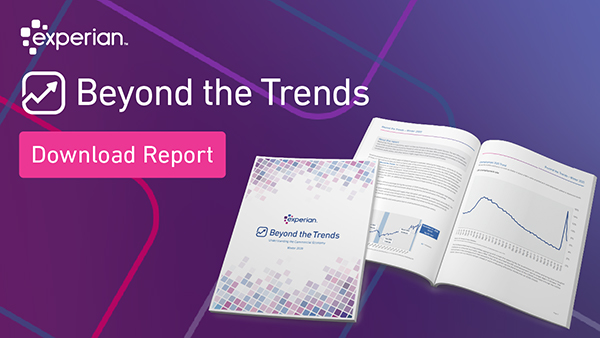
This perception of the marketplace has been a concern of consumers and small business owners, in the US, as they manage through the pandemic hampered marketplace.
Small businesses are adjusting to a high demand/ low supply market that is expected to continue through 2022. The ability to move raw materials to manufacturers, products across borders, find space in warehouses, and put products on the shelf has become challenging as pandemic variants add pressure to a slowly recovering supply infrastructure. Large market participants will find disproportionate advantage, over small business competitors, widens as distributors focus on their largest clients and small clients feel cost and availability squeeze. Consumers store front engagement will increase, with a tangible delivery advantage, as distrust grows in a digital only storefronts ability to deliver on time.
Here’s my quick take on what’s in our latest Beyond The Trends Report
The Experian Winter 2021 Beyond the Trend report looks at consumer willingness and ability to spend behavior tied to the bets commercial supply chain industry participants are making, to ensure demand is met, emerging from the heart of the pandemic:
- Originations for new businesses, with less than a year in business and already participating in the commercial credit market, are up 157% from pre-pandemic levels.
- 36% of active U.S. businesses have been operating less than 1 year, as the spike in new business applications continue to be elevated.
- Commercial lending up 95% from same time last year to supply chain participants (Manufacturing, wholesale, retail, transportation, and warehouse)
- Although delinquency rates are historically low rates for wholesalers (Up 600%) and retailers (Up 101%) have been on the rise a components and inventories are slow to arrive.
To operate at full capacity, small businesses will need consumers willing to spend. The fed will begin to taper and raise rates much earlier than expected, March 2022, to add downward pressure to inflation. Small businesses are betting on growth as investors view variants as a bump in the road vs a blocker. New business applications continued to roll at ~400k a month in 2021. This untapped market expansion will drive traditional lenders to reassess the risk of engaging emerging businesses in their first year of operation with limited historical commercial performance.
Supply chain bottlenecks will slowly dissipate. We expect to see variability in product availability as goods are delivered which will create scenarios of over-supply of some products while others remain tied up in transit. Lenders and creditors should monitor commercial health of businesses they interact with directly and indirectly to ensure portfolio stability and accurate risk based pricing.
2022 will be a recovery year for the US market. Consumers keep shopping! Small businesses keep fighting! The shelves will be full soon.
